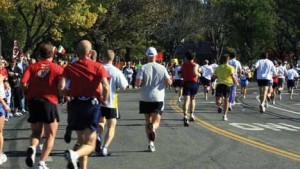Health Professional Corner
Hyponatraemia in marathon runners: Is it a real problem?
Professor Ron Maughan, Emeritus Professor of Sport and Exercise Nutrition, Loughborough University (UK).
For many years, the advice to those taking part in endurance activities was to be sure to drink enough to prevent dehydration. Because this advice was initially developed for elite athletes in sports such as marathon running, the advice was often to drink as much as possible. This was based on the fact that the elite runner taking just a little over 2 hours to complete the race in men and a bit less than 2½ hours in women, were working close to their maximum and had limited opportunities for drinking. Until the advent of popular marathons, there were also rather few drinking stations – nothing before 10 miles (16 km) and then every 5 miles (8 km) thereafter. In practice, drinking as much as possible usually translated into drinking not very much at all.
 Today, most major marathons have drinks stations every mile (1.6 km) and the average finishing time in many big city races is about 4½ hours for men and 5 hours for women. At these much slower speeds, sweat rates will be much lower, but the opportunities for drinking at every station are far greater. It is not surprising, therefore, that the slower runner who follows the advice to drink as much as possible will drink far more than is needed to balance sweat losses.
Today, most major marathons have drinks stations every mile (1.6 km) and the average finishing time in many big city races is about 4½ hours for men and 5 hours for women. At these much slower speeds, sweat rates will be much lower, but the opportunities for drinking at every station are far greater. It is not surprising, therefore, that the slower runner who follows the advice to drink as much as possible will drink far more than is needed to balance sweat losses.
Drinking excessive amounts will lead to a dilution of the sodium concentration in the blood plasma – a condition known as hyponatraemia. Mild hyponatraemia – or even a more marked hyponatraemia that develops very slowly – is fairly harmless, but a large and rapid fall in the plasma sodium level will lead to an influx of water into the body’s cells to balance the osmotic forces. Increasing the water content of the brain can lead to an increase pressure within the skull: at its most serious, this can lead to seizures and coma and, very occasionally, it can prove fatal. It is important to drink enough, but common sense would suggest that high rates of fluid intake are not needed by slow runners in cool weather. This message should be communicated by race organisers to all participants.